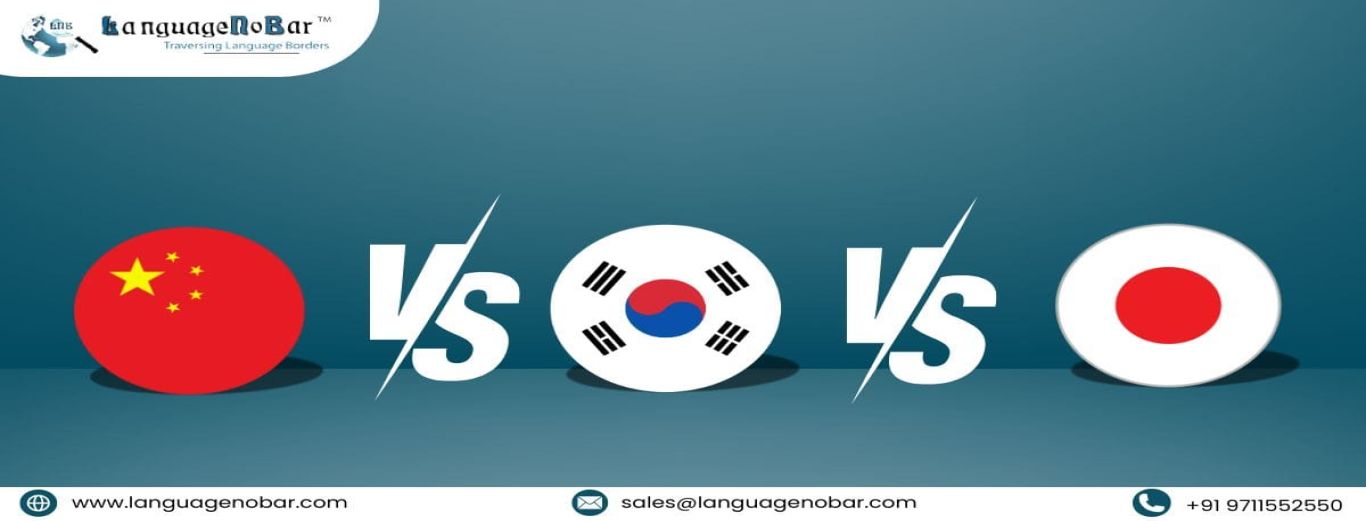Chinese vs Japanese vs Korean Languages: Alike and Different
- Foreign Language Translation Services
- Comments (0)
The geographical proximity of China, Korea, and Japan has profoundly impacted their cultural, linguistic, and social structure. But the trinity of China, Korea, and Japan have many more dissimilarities than what meets the eye. From the business POV, while China is the second largest economy in 2024, at around 18.5 trillion U.S. dollars, Japan stands at 4.1, and South Korea at 1.76.
But is the difference confined to business alone? Not quite. A closer look at the Languages gives a glimpse into the similarities and differences between Chinese, Korean, and Japanese languages and how they affect businesses looking at business prospects from these countries.
In this blog, we take a deep dive into the Chinese vs Japanese vs Korean language debate and shed light on why organizations need help from certified translation services so that things don’t get lost in translation.
An Overview: Chinese vs Japanese vs Korean
Contrary to popular belief, new research claims that Chinese, Japanese, and Korean don’t even come from the same language family!
The Chinese language is believed to belong to the Sino-Tibetan language family . There is an ongoing debate on the origin of Japanese as it is said to belong to the Japonic language family and Korean to the Koreanic language family. Each of these languages shares a common thread in many areas but they differ in the way grammar, vocabulary, and pronunciation are used.
The Chinese language is one of the oldest known languages and dates back over 3,000 years and has had a significant impact on both the Korean and Japanese languages’ vocabulary and writing systems. The Chinese language unlike English is based on the pronunciation of characters and is called “Hanji”. Chinese is the hardest language to pronounce, followed by Korean and then Japanese.
Similarities and Dissimilarities between Chinese and Japanese
The Japanese vocabulary includes approx. 18% of daily usage words from Chinese. Japan adopted the writing system of the Chinese script and used it to develop its style of writing where the characters are called “Kanji”.
However, since the Chinese and Korean languages differed significantly in their syntax and phonology, certain modifications were made to the characters and words to adapt to the Japanese way of language. Japanese now use a threefold system involving Kanji, Katakana, and Hiragana.
Here are some examples of how the same characters mean totally different things in Chinese and Japanese:
- 時計: ”Clock” in Japanese, “timer” in Chinese
- 床: ”Floor” in Japanese, “bed” in Chinese
- 透明: “Invisible” in Japanese, “transparent” in Chinese
For businesses looking to expand in these East Asian countries, partnering with Chinese translation services and Japanese translation services could help ensure that the communication in the form of website language or documents is right and there are no misinterpretations when it comes to communicating effectively and accurately with clients.
Read: Positives & Negatives of Using Google Translate For Business
Similarities and Dissimilarities between Chinese and Korean
Chinese characters are believed to have reached Korea in the 1st century and were modified into Korean sensibilities and the characters were called “Hanja”. Later Hangul-an alphabetic system was introduced which is mostly used now in Korea.
Here are some examples of how the same characters mean totally different things in Chinese and Korean:
- 行: "to walk" or "to do" in Chinese, "bank" in Korean
- 乐 / 樂: "happy" or "music" in Chinese, “music” or “pleasure in Korean
- 中 “Middle” in Chinese, can mean “central” in Korean
These are some differences between Chinese and Korean that may go unnoticed by the untrained eye. It needs a good hold on language and in-depth knowledge of languages. For businesses looking for translation requirements, the best option is to collaborate with a Korean translation agency that has a team of linguists, who understand the intricacies of the language and deliver information/messaging in the way it is meant to be.
Similarities and Dissimilarities between Japanese and Korean
Korean and Japanese have different linguistic origins and their writing systems are very different. Korean and Japanese have a considerable number of words from the Chinese language which are part of the academic, technical, or formal vocabulary.
Here are some examples of characters that have different meanings in Japanese and Korean:
- 하루: "spring" or "sun." in Japanese, "Day" or "a single day" in Korean.
- 언니: "Demon" or "ogre" in Japanese, "Older sister" in Korean.
- 내일: "Inside the stomach" in Japanese, "Tomorrow." in Korean.
All three languages differ in their grammatical structures and pronunciation systems, but there is one factor that binds them and it is the vocabulary. Some characters have similar meanings and pronunciations in both Japanese and Chinese, and some others have different meanings and it needs trained professionals who specialize in Chinese translation services and Japanese translation services, to understand the difference and provide the right translation job.
LanguageNoBar: Proficient Linguistic Experts Who Understand Language Best
Organizations looking to scale globally must prioritize cultural sensitivity, norms, and the sensibilities of their target audience. Language plays a pivotal role in these interactions. Today's business collaborations can open avenues for growth, while any oversights can lead to shifts in loyalty. We are a certified translation service provider, delivering high-quality Chinese Translation Services, Japanese Translation Services, and Korean, along with over 250 other languages. We understand the intricacies involved in each of these languages, the linguistic origins, writing systems, grammar, pronunciation, and cultural influences. At LanguageNoBar, each translation project is handled by a team of linguists, who are committed to delivering excellence at every step.







